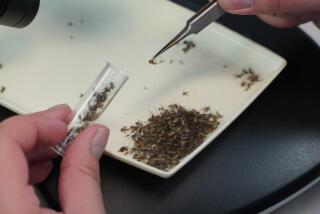Hordes of Mosquitoes Afflict Gulf Coast
- Share via
HOUSTON — As a longtime Houston-area resident, Beanie Rowland is something of a mosquito expert. But nothing prepared her for the swarms that descended on her rural home after Tropical Storm Allison.
“These aren’t ordinary mosquitoes,” she said. “These are terrible. . . . You think they might come and carry you away.”
For weeks, people along the Gulf Coast have been living in misery as mosquitoes have hatched by the millions in flood waters left by the storm. Although the insect population has dropped considerably in recent days, there may be trouble ahead. The initial explosion likely set off a ferocious cycle of biting and breeding that could last through the summer, some mosquito experts say.
“The problem is there are an awful lot of eggs laid by mosquitoes over the past two weeks,” said Mike Carroll, assistant director of the New Orleans Mosquito Control Board. “There’s no reason to believe there aren’t millions of eggs out there waiting to be hatched. This could have a ripple effect throughout the season.”
That’s bad news for people whose days are spent swatting airborne attackers and stripping store shelves of bug repellent. As mosquitoes go, one variety spawned by Allison is particularly vicious--leaving a trail of red welts the size of silver dollars. “Those would be salt marsh mosquitoes,” said Glen Stokes, head of mosquito control in Iberia Parish, west of New Orleans. “They’re very aggressive and bite during the day.”
It was impossible to avoid that or any other variety of mosquito in the days that followed the storm that swamped Houston earlier last month. Mosquitoes were landing on people at a rate of up to 100 a minute. In New Orleans, mosquito traps that normally caught up to 25 females were yielding 600 to 700 per trap.
While there is no evidence of human exposure to encephalitis or other viruses carried by mosquitoes, “this was the worst situation I’ve ever seen in an urban area,” said Dr. Ray Parsons, head of mosquito control in Harris County, Texas, which includes Houston. Mosquitoes were so severe here that the Federal Emergency Management Agency is paying for most of the spraying costs, which are still undetermined.
Relief came to Houston with 33 sprayer-equipped trucks blowing clouds of insecticide through the night for 10 days. Neighbors stood on sidewalks and applauded, then scurried inside for air. Rural areas in adjacent counties still are battling the hordes. At the Chambers County courthouse east of Houston, mosquitoes gather at the front steps, darting inside when the door is opened. “They come in and get under our desks. We all have our own little spray cans of Raid,” said Rowland, who is the county clerk.
She also keeps a can of fogger handy at home, which she sprays on her dogs. “The mosquitoes just eat them up alive otherwise,” Rowland said. At night, she can hear the cows across the street, restless and uncomfortable. “They bunch together and move as a group to keep the bugs off.”
Nearly 60 species of mosquitoes are known to breed in Texas and Louisiana. The post-Allison swarms largely can be traced to varieties that lay eggs in dry spots. These eggs, which hatch after a soaking flood, accumulated while the region went through a relatively dry spell. When the rains came, nearly two years’ worth of mosquito eggs hatched at the same time.
The explosion is just the latest in a year of infestations that has brought crickets to Utah barley fields, beetles to New York maple trees and gnats to Arizona households.
For the onslaught to end, the Gulf Coast needs a cold snap or a good long dry spell, Stokes said. And with summer just getting underway and after more rain that fell over the weekend, neither is likely to happen soon.
More to Read
Sign up for Essential California
The most important California stories and recommendations in your inbox every morning.
You may occasionally receive promotional content from the Los Angeles Times.













